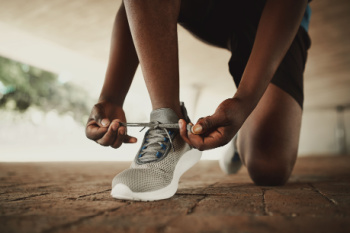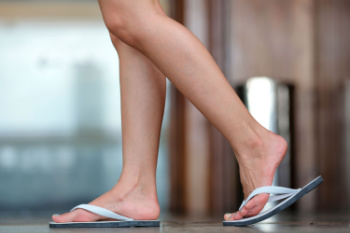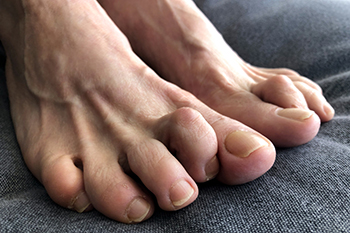Items filtered by date: July 2025
How Workout and Running Shoes Differ

Running shoes and workout shoes are built to support the feet in different ways, based on how each activity affects movement and impact. Running shoes are designed to absorb repeated forward motion, with extra cushioning in the midsole to help reduce the pressure on the feet during long-distance runs. They often have a higher heel-to-toe drop to cushion the heel strike, which helps protect the arches and ankles from overuse injuries. In contrast, workout shoes are made for side-to-side movement, quick pivots, and a range of activities that demand better ankle support and foot stability. These shoes generally have flatter soles and flexible materials to allow natural foot motion during squats, jumps, or lateral drills. A podiatrist can help assess foot structure and advise on proper footwear to reduce injury risks and manage pain. If you are experiencing foot pain after working out or running, it is suggested that you schedule an appointment with a podiatrist for an exam, treatment options, and guidance in choosing the correct shoes for your desired activity.
It is important to find shoes that fit you properly in order to avoid a variety of different foot problems. For more information about treatment, contact Jack A. Sasiene, DPM from Texas. Our doctor will treat your foot and ankle needs.
Proper Shoe Fitting
Shoes have many different functions. They cushion our body weight, protect our feet, and allow us to safely play sports. You should always make sure that the shoes you wear fit you properly in order to avoid injuries and deformities such as: bunions, corns, calluses, hammertoes, plantar fasciitis, stress fractures, and more. It is important to note that although a certain pair of shoes might be a great fit for someone else, that doesn’t mean they will be a great fit for you. This is why you should always try on shoes before buying them to make sure they are worth the investment. Typically, shoes need to be replaced ever six months to one year of regular use.
Tips for Proper Shoe Fitting
- Select a shoe that is shaped like your foot
- Don’t buy shoes that fit too tight, expecting them to stretch to fit
- Make sure there is enough space (3/8” to ½”) for your longest toe at the end of each shoe when you are standing up
- Walk in the shoes to make sure they fit and feel right
- Don’t select shoes by the size marked inside the shoe, but by how the shoe fits your foot
The shoes you buy should always feel as good as they look. Shoes that fit properly will last longer, feel better, and improve your way of life each day.
If you have any questions please contact our office located in Lake Jackson, TX . We offer the newest diagnostic and treatment technologies for all your foot and ankle needs.
How Wearing Flip-Flops Can Hurt Your Feet

Flip-flops may feel convenient in warm weather, but wearing them for long periods of time can lead to foot problems. Their flat, thin soles often lack arch support and cushioning, which can place extra strain on the plantar fascia, a thick band of tissue that supports the bottom of the foot. This may lead to heel pain or plantar fasciitis. Because flip-flops do not secure the foot well, the toes often grip to keep the shoe in place, which can fatigue the muscles and cause discomfort in the ball of the foot. The lack of structure can also affect alignment, placing stress on the ankles and contributing to tendon strain, especially in the arch area. Walking long distances in flip flops may increase the risk of overuse injuries and make existing foot conditions worse. If you are experiencing foot pain after spending the day in flip-flops, it is suggested that you schedule an appointment with a podiatrist for a diagnosis, treatment plan, and guidance on appropriate footwear.
Flip-flops can cause a lot of problems for your feet. If you have any concerns about your feet or ankles, contact Jack A. Sasiene, DPM from Texas. Our doctor will assist you with all of your foot and ankle needs.
Flip-Flops and Feet
Flip-flops have managed to become a summer essential for a lot of people. While the shoes may be stylish and easy to slip on and off, they can be dangerous to those who wear them too often. These shoes might protect you from fungal infections such as athlete’s foot, but they can also give you foot pain and sprained ankles if you trip while wearing them.
When Are They Okay to Wear?
Flip-flops should only be worn for very short periods of time. They can help protect your feet in places that are crawling with fungi, such as gym locker rooms. Athlete’s foot and plantar warts are two common fungi that flip-flops may help protect your feet against.
Why Are They Bad for My Feet?
These shoes do not offer any arch support, so they are not ideal for everyday use. They also do not provide shock absorption or heel cushioning which can be problematic for your feet. Additionally, you may suffer from glass cuts, puncture wounds, and stubbed toes since they offer little protection for your feet.
More Reasons Why They Are Bad for Your Feet
- They Slow You Down
- May Cause Blisters and Calluses
- Expose Your Feet to Bacteria
If you have any questions, please feel free to contact our office located in Lake Jackson, TX . We offer the newest diagnostic and treatment technologies for all your foot care needs.
Possible Causes of Toenail Loss

Toenail loss can happen for several reasons, and is often painful. Injuries from stubbing the toe or dropping something on it are common causes. Fungal infections may also damage the nail and make it loosen over time. Runners are at risk of toenail loss caused by repeated impact against the inside of the shoe, especially during long distances or downhill strides. Some people may develop a bony growth under the nail, called a subungual exostosis, which puts pressure on the nail until it detaches. Illness, certain medications, or poor circulation may also cause nail loss. If a toenail falls off, a new nail must grow, which can take several months to a year. If part of the nail is still attached, do not pull it off. That can lead to infection or injury. A podiatrist can examine the toe, remove a damaged nail safely, and guide proper regrowth. If your toenail falls off, it is suggested that you promptly schedule an appointment with a podiatrist for appropriate treatment.
For more information about treatment, contact Jack A. Sasiene, DPM of Texas. Our doctor can provide the care you need to keep you pain-free and on your feet.
Toenail Fungus Treatment
Toenail fungus is a condition that affects many people and can be especially hard to get rid of. Fortunately, there are several methods to go about treating and avoiding it.
Antifungals & Deterrence
Oral antifungal medicine has been shown to be effective in many cases. It is important to consult with a podiatrist to determine the proper regiment for you, or potentially explore other options.
Applying foot powder on the feet and shoes helps keep the feet free of moisture and sweat.
Sandals or open toed shoes – Wearing these will allow air movement and help keep feet dry. They also expose your feet to light, which fungus cannot tolerate. Socks with moisture wicking material also help as well.
If you have any questions please contact our office located in Lake Jackson, TX . We offer the newest diagnostic and treatment technologies for all your foot and ankle needs.
Common Foot Disorders in the Elderly

Foot disorders in the elderly population are common due to natural aging, changes in biomechanics, and the long-term effects of chronic conditions. As people age, their feet may lose strength, flexibility, and cushioning. This process increases the risk of developing arthritis, bunions, hammertoes, and poor circulation. Biomechanical changes can alter walking patterns, leading to instability and discomfort. These issues can impact mobility, independence, and overall well-being. A podiatrist can assess the feet, diagnose underlying problems, and provide personalized treatment, including custom orthotics and footwear recommendations. If you are experiencing any foot pain, it is suggested that you schedule a visit with a podiatrist who can treat various foot conditions and guide you on foot care tips.
If you need your feet checked, contact Jack A. Sasiene, DPM of Texas. Our doctor will attend to all of your foot and ankle needs and provide you with quality treatment.
Geriatrics and Podiatry
When people age, some common issues that may occur are bone density loss, dry skin, poor circulation, and rough brittle nails. These issues may also affect your foot health if the necessary steps are not taken to alleviate the problems.
It is important to take care of your feet because feet that are injured or diseased can affect your overall health. Having painful feet hinders your ability to do daily activities or may decrease your willingness to do the things that you need to do.
Visiting Your Geriatrician
As we age, health problems become more likely, so it is essential to visit your doctor for check-ups to ensure that you are doing the best you can to take care of your health. It is recommended to check your feet frequently for any possible cuts, bruises, swelling, corns or any other irregularities.
Taking Care of Elderly Feet
Cracked or dry feet can be treated by applying moisturizer often. It is also important not to wear old socks because the older the sock is, the higher the possibility there will be that there is bacteria there. Wear fresh socks and make sure they fit properly.
Proper foot health means that you can have a more active lifestyle and you will not be bogged down by pain. Foot health also leads to good circulation, which is paramount for overall health.
If you have any questions, please feel free to contact our office located in Lake Jackson, TX . We offer the newest diagnostic and treatment technologies for all your foot care needs.
What Is Hammertoe?

Hammertoe is a condition where one or more toes become bent at the middle joint, resembling a hammer. It often develops from wearing tight shoes or high heels that force the toes into a curled position. Causes may also include muscle imbalance, trauma, or arthritis. Symptoms include pain, stiffness, swelling, and difficulty wearing shoes. Risk factors include age, foot structure, and a history of foot problems. If left untreated, the joint can become rigid and require surgery to correct the problem. A podiatrist can evaluate the severity, recommend proper footwear, suggest exercises, or provide splints or custom orthotics. If you have symptoms of hammertoe, it is suggested that you consult a podiatrist who can offer effective treatment solutions.
Hammertoes can be a painful condition to live with. For more information, contact Jack A. Sasiene, DPM of Texas. Our doctor will answer any of your foot- and ankle-related questions.
Hammertoe
Hammertoe is a foot deformity that occurs due to an imbalance in the muscles, tendons, or ligaments that normally hold the toe straight. It can be caused by the type of shoes you wear, your foot structure, trauma, and certain disease processes.
Symptoms
- Painful and/or difficult toe movement
- Swelling
- Joint stiffness
- Calluses/Corns
- Physical deformity
Risk Factors
- Age – The risk of hammertoe increases with age
- Sex – Women are more likely to have hammertoe compared to men
- Toe Length – You are more likely to develop hammertoe if your second toe is longer than your big toe
- Certain Diseases – Arthritis and diabetes may make you more likely to develop hammertoe
Treatment
If you have hammertoe, you should change into a more comfortable shoe that provides enough room for your toes. Exercises such as picking up marbles may strengthen and stretch your toe muscles. Nevertheless, it is important to seek assistance from a podiatrist in order to determine the severity of your hammertoe and see which treatment option will work best for you.
If you have any questions, please feel free to contact our office located in Lake Jackson, TX . We offer the newest diagnostic and treatment technologies for all your foot care needs.

